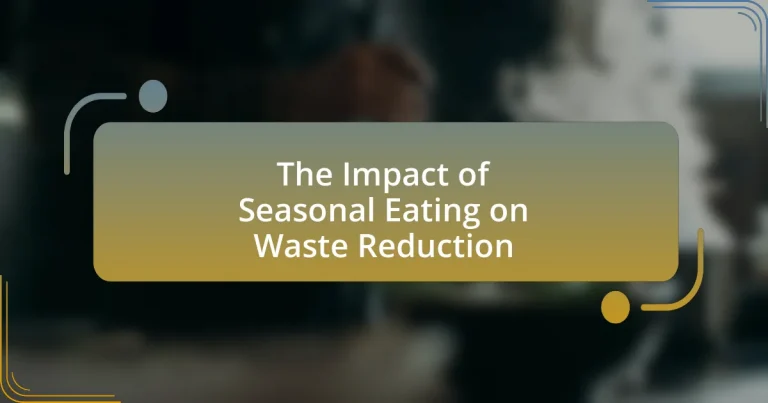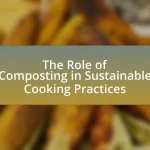The article examines the impact of seasonal eating on food waste reduction, highlighting how aligning consumption with natural harvest cycles can decrease waste by up to 30%. It discusses the benefits of consuming locally grown, in-season produce, which is fresher and less likely to spoil, thereby supporting local agriculture and minimizing environmental impact. Key principles of seasonal eating, challenges faced by consumers, and strategies for promoting awareness and accessibility are also explored, along with the environmental and economic advantages of reducing food waste through seasonal practices. The article emphasizes practical steps individuals can take to embrace seasonal eating, including meal planning and utilizing local resources.
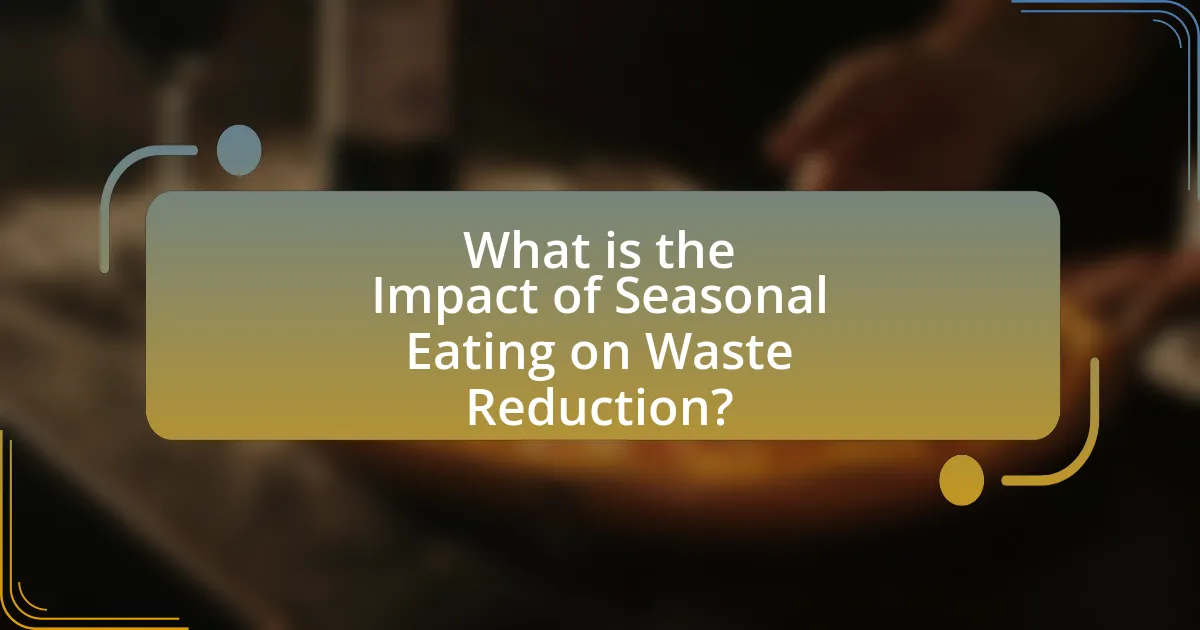
What is the Impact of Seasonal Eating on Waste Reduction?
Seasonal eating significantly reduces food waste by aligning consumption with the natural harvest cycles of fruits and vegetables. When consumers choose to eat foods that are in season, they are more likely to purchase fresh produce that is at its peak quality and availability, leading to less spoilage and waste. According to a study published in the journal “Waste Management,” seasonal eating can decrease food waste by up to 30% because it encourages the use of local produce, which has a shorter supply chain and is less likely to be discarded due to long transportation times. Additionally, seasonal eating promotes awareness of food availability, encouraging consumers to plan meals around what is fresh, further minimizing waste.
How does seasonal eating contribute to reducing food waste?
Seasonal eating contributes to reducing food waste by aligning food consumption with the natural harvest cycles, which minimizes the likelihood of spoilage and excess production. When consumers choose seasonal produce, they support local farmers who grow crops that are in peak condition, leading to fresher products that have a longer shelf life. According to a study by the Food and Agriculture Organization, approximately one-third of food produced globally is wasted, and seasonal eating can significantly mitigate this by ensuring that food is consumed at its freshest point, thereby reducing the volume of food that goes unsold and discarded.
What are the key principles of seasonal eating?
The key principles of seasonal eating include consuming fruits and vegetables that are harvested during their natural growing seasons, which enhances flavor and nutritional value. This practice supports local agriculture, reduces carbon footprints associated with transportation, and minimizes food waste by aligning consumption with peak harvest times. Research indicates that seasonal produce is often fresher and more nutrient-dense, as it is picked at its peak ripeness, leading to better taste and health benefits. Additionally, seasonal eating encourages variety in the diet, as it promotes the consumption of diverse foods throughout the year, which can help reduce reliance on processed foods and contribute to sustainable eating habits.
How does the availability of seasonal produce affect waste levels?
The availability of seasonal produce significantly reduces waste levels. When fruits and vegetables are in season, they are typically harvested at their peak ripeness, leading to higher quality and better flavor, which encourages consumption. According to a study by the Food and Agriculture Organization, seasonal produce has a lower carbon footprint and is less likely to spoil during transport, resulting in reduced food waste. Additionally, local markets often sell seasonal items, which can lead to shorter supply chains and fresher products, further minimizing waste.
Why is waste reduction important in the context of seasonal eating?
Waste reduction is important in the context of seasonal eating because it minimizes food waste by aligning consumption with the natural harvest cycles. Seasonal eating encourages the purchase of locally grown produce, which is often fresher and has a shorter supply chain, reducing the likelihood of spoilage. According to the USDA, approximately 30-40% of the food supply in the United States is wasted, and seasonal eating can significantly lower this statistic by promoting the use of ingredients at their peak freshness and availability. By consuming foods that are in season, individuals can better plan their meals, leading to less food being discarded and a more sustainable food system overall.
What environmental benefits arise from reducing food waste?
Reducing food waste leads to significant environmental benefits, including decreased greenhouse gas emissions and conservation of natural resources. When food is wasted, it contributes to approximately 8-10% of global greenhouse gas emissions, primarily from decomposing organic matter in landfills. By minimizing food waste, we can reduce the methane emissions produced, which is a potent greenhouse gas. Additionally, reducing food waste conserves water and energy used in food production; for instance, it takes about 1,800 gallons of water to produce just one pound of beef. Therefore, cutting down on food waste not only mitigates climate change but also preserves vital resources.
How does food waste impact local economies?
Food waste negatively impacts local economies by reducing potential revenue for businesses and increasing disposal costs. When food is wasted, it represents a loss of income for farmers, retailers, and restaurants, which can lead to decreased economic activity in the community. According to the USDA, approximately 30-40% of the food supply in the United States is wasted, translating to an economic loss of about $161 billion annually. This loss affects local job creation and can strain municipal budgets due to higher waste management expenses. Additionally, food waste contributes to environmental degradation, which can further impact local economies reliant on tourism and agriculture.
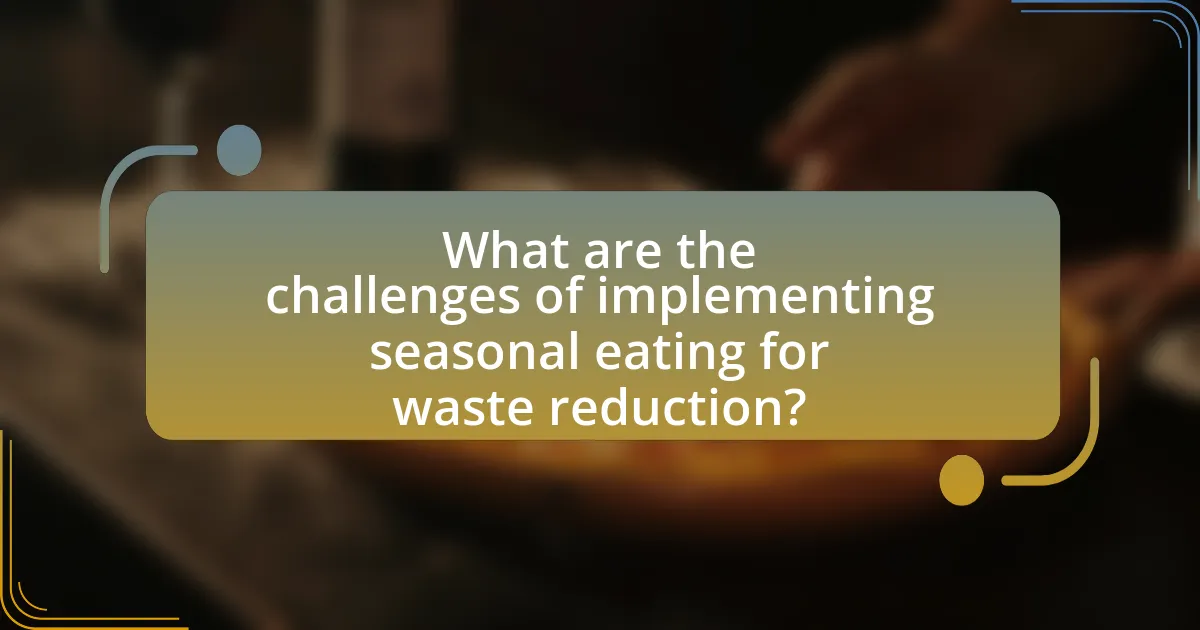
What are the challenges of implementing seasonal eating for waste reduction?
Implementing seasonal eating for waste reduction faces several challenges, including limited availability of certain foods, consumer habits, and infrastructure issues. Limited availability occurs when specific seasonal foods are not accessible in all regions, leading to reliance on imported items that may contribute to waste. Consumer habits present a challenge as many individuals are accustomed to year-round access to a variety of foods, making it difficult to shift towards a seasonal mindset. Additionally, infrastructure issues, such as inadequate storage and distribution systems for seasonal produce, can hinder the effective implementation of seasonal eating practices. These challenges collectively impact the potential for waste reduction associated with seasonal eating.
What barriers do consumers face in adopting seasonal eating habits?
Consumers face several barriers in adopting seasonal eating habits, primarily including limited availability of seasonal produce, lack of awareness about seasonal options, and higher costs associated with fresh, local foods. Limited availability occurs when consumers cannot find seasonal items in their local grocery stores or markets, which can discourage them from pursuing seasonal eating. Lack of awareness is significant, as many consumers are not informed about what foods are in season, leading to reliance on out-of-season produce that is often imported. Additionally, higher costs can deter consumers, as seasonal and local foods may be priced higher than mass-produced alternatives, making them less accessible to budget-conscious shoppers. These barriers collectively hinder the adoption of seasonal eating habits, impacting both consumer choices and waste reduction efforts.
How do cultural preferences influence seasonal eating?
Cultural preferences significantly influence seasonal eating by dictating which foods are valued and consumed during specific times of the year. For instance, in Mediterranean cultures, seasonal eating is characterized by an emphasis on fresh vegetables and fruits during summer, while winter months focus on preserved foods like olives and citrus. This practice is rooted in historical agricultural cycles and local climate conditions, which shape dietary habits and food availability. Research indicates that cultures with strong seasonal eating traditions often experience reduced food waste, as these practices encourage the consumption of locally sourced, in-season produce, thereby minimizing reliance on imported goods and processed foods.
What role does accessibility play in seasonal eating practices?
Accessibility significantly influences seasonal eating practices by determining the availability and affordability of seasonal produce. When consumers have easy access to fresh, locally grown fruits and vegetables, they are more likely to incorporate these items into their diets, thereby promoting seasonal eating. Research indicates that regions with farmers’ markets or community-supported agriculture programs see higher rates of seasonal consumption, as these platforms enhance accessibility to fresh produce. For example, a study published in the Journal of Agriculture, Food Systems, and Community Development found that communities with better access to local food sources reduced food waste by 30%, highlighting the direct correlation between accessibility and sustainable eating practices.
How can education promote seasonal eating to reduce waste?
Education can promote seasonal eating to reduce waste by providing individuals with knowledge about the benefits of consuming locally sourced, in-season foods. This knowledge helps consumers understand that seasonal foods are often fresher, more nutritious, and less likely to spoil, which directly contributes to waste reduction. For instance, a study by the Food and Agriculture Organization indicates that seasonal produce has a lower carbon footprint due to reduced transportation needs, further emphasizing the environmental benefits of seasonal eating. By integrating this information into school curricula, community programs, and public awareness campaigns, education can effectively encourage sustainable eating habits that minimize food waste.
What strategies can be used to educate consumers about seasonal produce?
To educate consumers about seasonal produce, effective strategies include implementing community workshops, utilizing social media campaigns, and partnering with local farmers’ markets. Community workshops can provide hands-on experiences, teaching consumers how to select, prepare, and store seasonal fruits and vegetables, thereby increasing their awareness and appreciation. Social media campaigns can disseminate information about the benefits of seasonal eating, including nutritional value and environmental impact, reaching a broader audience quickly. Collaborating with local farmers’ markets allows consumers to engage directly with producers, fostering a connection that encourages the purchase of seasonal items. Research indicates that consumers who are educated about seasonal produce are more likely to make informed purchasing decisions, which can lead to reduced food waste and a lower carbon footprint.
How can community programs support seasonal eating initiatives?
Community programs can support seasonal eating initiatives by organizing local farmers’ markets that provide access to fresh, seasonal produce. These markets not only connect consumers directly with local farmers, reducing transportation emissions and food waste, but also educate the community about the benefits of eating seasonally. Research indicates that seasonal eating can lead to a 30% reduction in food waste, as it encourages the consumption of produce at its peak freshness and minimizes the likelihood of spoilage. Additionally, community programs can offer workshops and cooking classes that highlight seasonal recipes, further promoting the use of local ingredients and fostering a culture of sustainability.
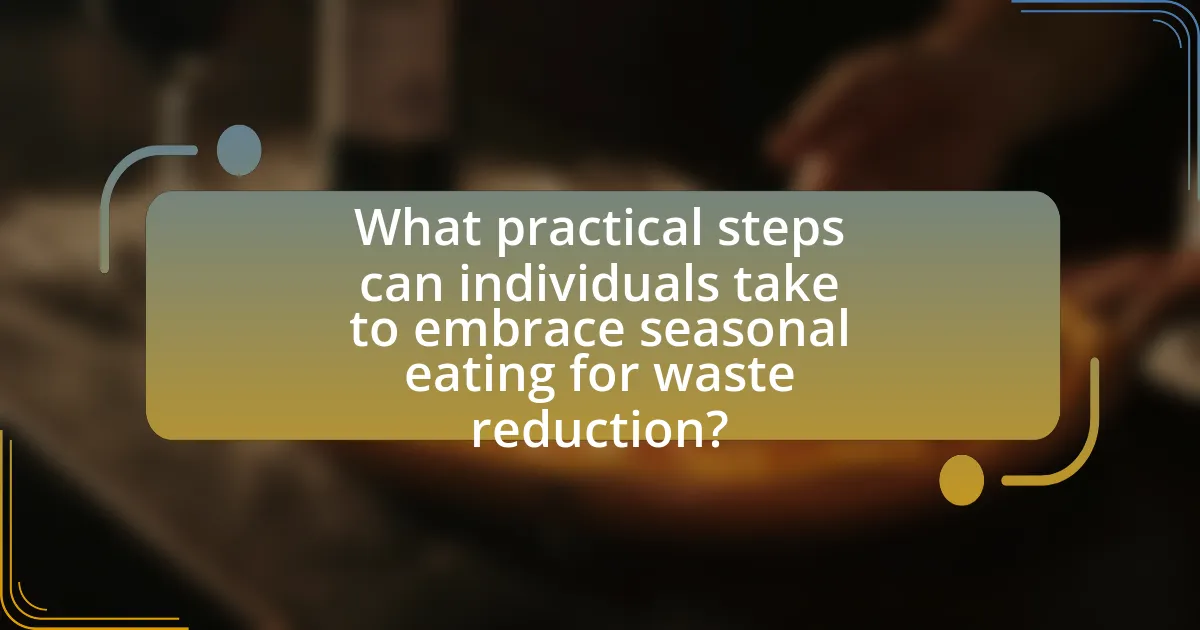
What practical steps can individuals take to embrace seasonal eating for waste reduction?
Individuals can embrace seasonal eating for waste reduction by planning meals around local harvests, which minimizes food waste and supports local agriculture. By purchasing fruits and vegetables that are in season, individuals reduce the likelihood of spoilage, as these items are fresher and have a longer shelf life. Research indicates that seasonal produce often requires less energy for transportation and storage, further decreasing environmental impact. Additionally, individuals can participate in community-supported agriculture (CSA) programs, which provide a direct link to local farms and encourage the consumption of seasonal produce. This practice not only reduces waste but also fosters a connection to the food source, enhancing awareness of seasonal cycles.
How can meal planning enhance seasonal eating practices?
Meal planning enhances seasonal eating practices by promoting the use of locally available ingredients, which reduces food waste and supports sustainable agriculture. By organizing meals around seasonal produce, individuals can ensure they are purchasing items at their peak freshness and nutritional value, leading to less spoilage. Research indicates that seasonal eating can decrease food waste by up to 30% as it encourages consumers to buy only what they need for planned meals, minimizing excess purchases that often go uneaten. This strategic approach not only benefits personal health but also contributes to environmental sustainability by reducing the carbon footprint associated with transporting out-of-season foods.
What tools can help individuals identify seasonal produce?
Tools that can help individuals identify seasonal produce include seasonal produce calendars, mobile apps, and local farmers’ markets. Seasonal produce calendars provide a visual guide that indicates which fruits and vegetables are in season during specific months, helping consumers make informed choices. Mobile apps, such as “Seasonal Food Guide” and “Harvest,” offer real-time information on seasonal produce based on geographic location, allowing users to easily access data on what is currently available. Additionally, visiting local farmers’ markets connects individuals directly with local growers, who can provide insights on what is in season and freshly harvested. These tools collectively promote awareness of seasonal eating, which can contribute to waste reduction by encouraging the purchase of locally sourced and in-season foods.
How can individuals incorporate seasonal foods into their diets effectively?
Individuals can effectively incorporate seasonal foods into their diets by planning meals around what is currently in season, which enhances freshness and flavor while reducing waste. Seasonal foods are often harvested at their peak, providing better nutritional value and taste, and they typically require less transportation, leading to a lower carbon footprint. For example, consuming locally grown fruits and vegetables during their harvest season not only supports local farmers but also minimizes the environmental impact associated with long-distance food transport. Additionally, individuals can visit farmers’ markets or join community-supported agriculture (CSA) programs to access seasonal produce directly, ensuring they are eating what is fresh and available. This practice not only promotes a sustainable diet but also encourages variety in meals, as seasonal foods change throughout the year.
What are some best practices for reducing waste through seasonal eating?
Best practices for reducing waste through seasonal eating include planning meals around seasonal produce, which minimizes spoilage and maximizes freshness. By purchasing fruits and vegetables that are in season, consumers can reduce the likelihood of food waste, as these items are typically harvested at their peak ripeness and have a longer shelf life. Additionally, buying from local farmers’ markets can further decrease waste by reducing transportation emissions and ensuring that produce is consumed quickly. Research indicates that seasonal eating can lead to a 30% reduction in food waste, as seasonal foods are often more affordable and appealing, encouraging consumption rather than disposal.
How can individuals store seasonal produce to minimize waste?
Individuals can store seasonal produce to minimize waste by using proper preservation techniques such as refrigeration, freezing, canning, and drying. Refrigeration slows down spoilage for items like leafy greens and berries, while freezing preserves the nutritional value and freshness of fruits and vegetables for longer periods. Canning allows for long-term storage of seasonal produce by sealing it in airtight containers, which can last for years. Drying removes moisture, inhibiting the growth of bacteria and mold, making it ideal for herbs and fruits. According to the USDA, proper storage can reduce food waste by up to 30%, highlighting the effectiveness of these methods in extending the shelf life of seasonal produce.
What recipes can maximize the use of seasonal ingredients?
Recipes that maximize the use of seasonal ingredients include vegetable stir-fries, seasonal salads, and fruit-based desserts. Vegetable stir-fries utilize fresh, in-season vegetables like bell peppers, zucchini, and asparagus, which are at their peak flavor and nutritional value. Seasonal salads can incorporate greens, tomatoes, and cucumbers during summer months, providing a refreshing and nutrient-rich meal option. Fruit-based desserts, such as berry cobblers or peach crisps, leverage the natural sweetness and flavor of fruits that are ripe and abundant during their respective seasons. Utilizing these recipes not only enhances taste but also reduces food waste by encouraging the use of ingredients that are readily available and at their freshest.
